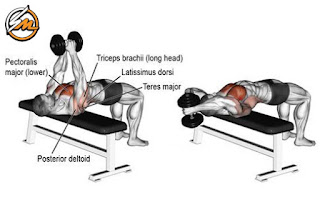A weak mid back could be the reason for your poor posture, lack of muscle definition in the back, and even lack of strength in exercises like deadlifts. However, with the right training program, you can target the mid-back muscles and see improvement relatively quickly.
Benefits Of Mid-Back Exercises
Engaging in mid-back exercises offers several benefits for your overall physical health and well-being. Here are some key advantages of incorporating mid-back exercises into your fitness routine:
Improved Posture: Mid-back exercises target the muscles responsible for maintaining good posture, such as the rhomboids and lower trapezius. Strengthening these muscles can help you develop better posture and alignment, reducing the likelihood of rounded shoulders or a forward head position.
Reduced Risk of Upper Back Pain: Weakness or imbalances in the mid-back muscles can contribute to upper back pain. By regularly performing mid-back exercises, you can strengthen and stabilize these muscles, reducing the risk of discomfort and tension in the upper back region.
Enhanced Upper Body Strength: The mid-back muscles play a crucial role in many upper body movements, including pulling, lifting, and carrying. Strengthening these muscles through targeted exercises can improve your overall upper body strength and functional performance in various activities.
Increased Shoulder Stability: Strong mid-back muscles, particularly the rhomboids and lower trapezius, provide support and stability to the shoulder joint. By strengthening these muscles, you can enhance shoulder stability, reducing the risk of injuries and improving your performance in sports or weightlifting exercises that involve overhead movements.
Balanced Muscle Development: Many people tend to focus on training the chest and front shoulder muscles, leading to muscle imbalances between the front and back of the upper body. Mid-back exercises help counteract this by targeting the neglected posterior chain, promoting balanced muscle development for aesthetic purposes and optimal functional movement.
Enhanced Athletic Performance: A strong mid-back improves your ability to generate power and transfer force efficiently during athletic movements like throwing, swinging, or rowing. It also aids in maintaining proper kinetic chain alignment, contributing to overall athleticism and performance in various sports and physical activities.
Injury Prevention: Weak mid-back muscles can increase the risk of shoulder injuries, impingements, and other upper body issues. By incorporating mid-back exercises into your routine, you can strengthen the muscles surrounding the shoulder girdle, improving joint stability and reducing the likelihood of injuries.
Improved Back Strength for Daily Activities: Strong mid-back muscles provide support for everyday activities such as lifting objects, carrying groceries, or performing household chores. Developing a strong mid-back can make these tasks easier and safer, reducing the strain on your back and minimizing the risk of back-related discomfort.
Remember to consult with a fitness professional before starting any new exercise program, especially if you have pre-existing conditions or injuries. They can guide you in selecting appropriate exercises and ensure proper form and technique to maximize the benefits and minimize the risk of injury.
The 10 Best Middle Back Exercises
When it comes to middle back exercises, there are several effective options to choose from. These exercises target the muscles in your thoracic region, which includes the middle of your back. Here are 10 of the best middle back exercises:
Bent-Over Rows:
This exercise strengthens the middle back muscles. Stand with your feet shoulder-width apart, bend your knees slightly, hinge forward at the hips, and hold a barbell or dumbbells. Pull the weights toward your torso while keeping your back straight.
Seated Cable Rows:
Sit on a rowing machine with your feet placed on the footrests. Grab the cable handles with an overhand grip and pull them toward your abdomen. Keep your back straight and squeeze your shoulder blades together.
Reverse Flyes:
Stand with your feet shoulder-width apart and hold a pair of dumbbells. Bend forward at the hips and keep a slight bend in your knees. Lift the dumbbells out to the sides until your arms are parallel to the ground, focusing on squeezing your shoulder blades together.
T-Bar Rows:
Position yourself on a T-bar row machine with your chest against the pad and your feet securely planted. Hold the handles with an overhand grip and pull the weight toward your abdomen while keeping your back straight.
Lat Pulldowns:
Sit on a lat pulldown machine and grab the wide bar with an overhand grip. Pull the bar down toward your upper chest, bringing your shoulder blades together. Control the movement as you release the weight back up.
Dumbbell Pullovers:
Lie on a bench with only your upper back touching the surface. Hold a dumbbell above your chest with both hands and lower it backward over your head until your arms are parallel to the floor. Return to the starting position while engaging your middle back muscles.
Superman Exercise:
Lie face down on the floor with your arms extended in front of you. Lift your chest, arms, and legs off the ground simultaneously while keeping your head aligned with your spine. Hold for a few seconds and then lower back down.
Prone Y Raises:
Lie face down on an exercise ball or bench. Extend your arms overhead to form a "Y" shape and lift them off the ground. Squeeze your shoulder blades together as you raise your arms.
Prone T Raises:
Similar to prone Y raises, lie face down on an exercise ball or bench but extend your arms outward to form a "T" shape. Lift your arms off the ground while squeezing your shoulder blades together.
Pull-Ups:
Grab a pull-up bar with an overhand grip and hang with your arms fully extended. Pull yourself up until your chin reaches above the bar by engaging your middle back muscles. Lower yourself down with control.
Remember to start with weights appropriate for your fitness level and gradually increase the intensity as you become stronger. It's also essential to maintain proper form throughout each exercise to minimize the risk of injury.















0 Comments